Spades (suit)
Spades ![]()
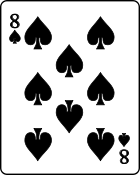
In French the suit of Spades is known as the Pique and in German as the Pik. It corresponds to the suit of Leaves ![]()
In Bridge, Spades rank as the highest suit. In Skat and similar games, it is the second-highest suit.
Name
The French name for this suit, pique ("pike"), meant, in the 14th century, a weapon formed by an iron spike placed at the end of a pike.[1] For playing cards, the term may have been coined by analogy with the Latin symbol from which it is derived, the sword.
In other languages, the term is usually derived from pique: German: Pik, Spanish: picas, Romanian: pică, Russian: пики, Czech: piky, Italian: picche etc. Sometimes it is an adaptation of "sword", hence the English name, Spades, and the Portuguese espadas.
Characteristics
The spade symbol is a very stylized spearhead shape, pointing upwards, the bottom widening into two arcs of a circle and sweeping towards the centre to then form a sort of foot.
Generally, spades are black. They form one of the two major suits in Bridge (with Hearts). In the official Skat tournament deck, spades are green, assuming the color of their German-deck equivalent.
The following gallery shows the spades in a 52-card deck of French playing cards. Not shown is the Knight of Spades used in Tarot card games:

 2
2 3
3 4
4 5
5 6
6 7
7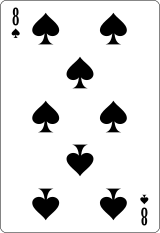 8
8 9
9 10
10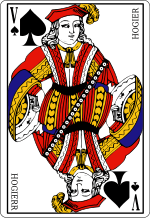 Jack
Jack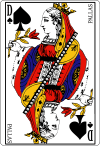
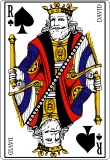 King
King
Four-colour packs
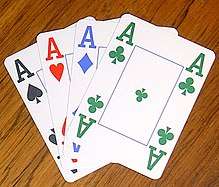
Four-colour packs are sometimes used in tournaments or online.[2] In four-colour packs Spades may be:
Coding
The symbol ♠ is already in the computer code set CP437 and therefore also part of Windows WGL4. In Unicode a black ♠ and a white ♤ Spade are defined:
| Symbol | Unicode | Entity in HTML |
|---|---|---|
| ♠ | U+2660 BLACK SPADE SUIT | ♠ or ♠ |
| ♤ | U+2664 WHITE SPADE SUIT | ♤ |
References
- "Pique". Centre national de ressources textuelles et lexicales.
- Allan & Mackay 2007, p. 155.
- Gallery 3 - Sizes, Shapes and Colours at a_pollett.tripod.com. Retrieved 4 Aug 2020.
- Gallery 3 - Sizes, Shapes and Colours at a_pollett.tripod.com. Retrieved 4 Aug 2020.
Literature
- Allan, Elkan and Hannah Mackay (2007). The Poker Encyclopedia. London: Portico. ISBN 978-1906-03209-8